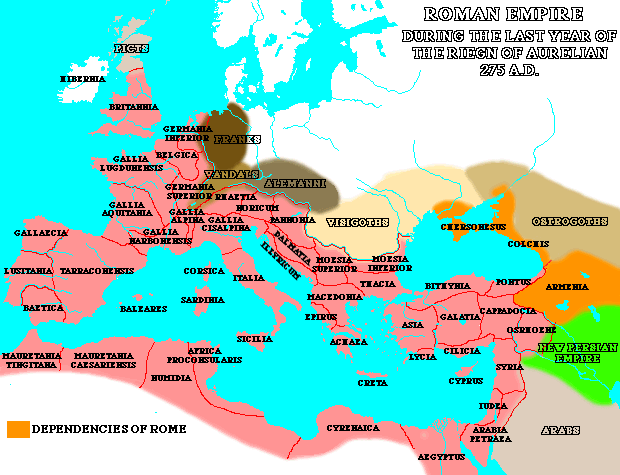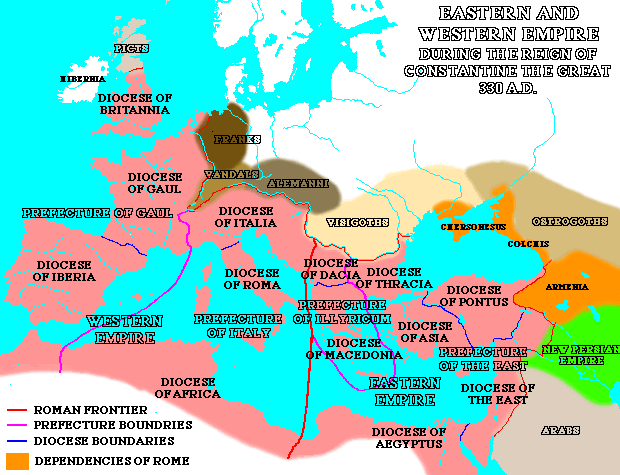Dictionary and Thesaurus
The reforms of Diocletian and Constantine "preserved" the empire, but changed
it radically.

The Reforms of Diocletian (284-305 d. 311)
Before you plunge into a consideration of Diocletian's reign, you might be
interested to know that much of the great palace he built for himself in
ex-Yugoslavia is still sufficiently intact to provide one with a good idea
of how the rulers of the Roman empire lived. You might want to
visit
it and look around.
1. Political
a. He divided the empire into two independent parts, leaving an
impoverished and vulnerable western empire. Note that the Western empire
had by far the longer frontier to defend, and a much smaller tax base with
which to pay for its defense.
b. Established the Augustus-Caesar policy of succession. Under this
system, there were two emperors (Augusti), each of whom appointed a
Caesar to defend the frontiers. When an emperor died, his Caesar
was supposed to succeed him, take over his administration, and appoint a
Caesar to defend the frontiers and eventually succeed to the emperorship.
This was an attempt to create a stable form of succession -- which had
been the weakness of the original empire -- but it failed.
c. Made the provinces smaller and appointed both a civil and military
governor over each. This generally increased government interference at
local level and took affairs out of the hands of the middle classes of the
provinces. Once they no longer had an important role in the governing of
the empire, the imperial administration was able to tax the urban middle
classes to the point of destroying them, at least in the western
empire.
d. Adopted Persian court ceremony to make the emperor sacrosanct and
removed from the people. This greatly changed the sense of public spirit
within the empire. In the first empire, the emperor had been extremely
powerful and -- after his death -- sometimes worshipped as a god. During
his lifetime, however, his status -- in theory at least -- was that of the
foremost of the citizens of Rome. After Diocletian's reforms, the emperor
became the "lord" of the empire. The later emperors rarely governed in
person, but acted through appointed officials. They were thus isolated
from the actual state of affairs in their realms and were often controlled
or at least greatly influenced by palace officials.
2. Economic
a. Ended debasement and re-established a gold standard. Unfortunately,
there was not enough gold in circulation to produce enough coins to support the
economy of the empire, and the monetary reform caused an economic depression.
Consider this basic economic formula: prices= [(credit+money) x velocity of
exchange] / supply. This means that, all other things being equal, if you
decrease the amount of money in circulation, the price of goods goes down.
Looked at in another way, the value of the money in circulation increases.
b. Reformed taxation
1. Reduced taxes to two: a property and a head (poll) tax. This simplified
matters, and was a combination of a progressive tax on the wealthy (the
property tax) and a flat tax upon all (the head tax). Unfortunately, both taxes
had to be quite heavy.
2. Ended practice of tax farming. Tax farming is a practice in which a
government auctions off the right to collect the taxes from a given district to
a collection company that pays cash for the concession. The tax collection
companies pay less than they expect to be able to collect, of course, and they
try to collect as much as possible. This leads to abuses. The collectors are
not responsible to the people but are trying to make as great a profit as
possible, and the government generally ignores their abuses. The more profit
the tax collectors make, the higher price they are willing to pay for the right
to collect taxes.
3. Exempted senatorial class from taxation. The descendants of anyone who had
served in the Roman Senate (a body that was restricted to the noble and
wealthy) continued to hold hereditary senatorial status. Immune from taxation
and many other expenses, the senatorial class held vast estates and were the
richest class in Roman society. This meant that the full weight of the property
tax fell on the small farmers and middle-class businessmen and artisans. The
farmers who could not pay their taxes could be enslaved (along with their wives
and children) and so gave their lands and their persons to local members
of the senatorial class. In this way, they avoided taxes but lost their
freedom, becoming tenant-farmers (coloni).
Considering how important historians consider the differences between the
slavery characteristic of the Ancient World and the serfdom prevalent in
Medieval Europe, You might what to take a look at
A Brief Essay on Serfdom and Slavery
4. Made the urban middle class (curiales) responsible for collecting
taxes. If their collections fell short of the government assessment, they were
required to pay the difference lout of their own pocket, or face sale of their
property and possible personal enslavement. Many curiales tried to flee to the
countryside and become coloni, but this was forbidden by law. The provincial
middle class, particularly in the western empire, was financially ruined, and
the center of economic and administrative life shifted from the cities to the
villas of the countryside.
3. Military
a. Abandoned frontier defense in favor of a defense in depth in which the
troops stationed along the frontier were expected only to slow down an
invader's advance until the field army could be brought up to oppose it. This
meant, of course, that the security of the lands near the Roman frontiers was
abandoned in the name of economy.
b. Downgraded the frontier legions, once the first-line troops of the Roman
army to the status of militia and garrison soldiers. Their armaments and
training were neglected, and their discipline and spirit decreased.
c. Hired "barbarian" mercenaries to man a mobile field army and
stationed them in the interior. This was a short-range economy. The role of the
army in building and maintaining the transportation system and in
spreading the roman ideal among both provincials and "barbarians" was ended,
and the transportation and communications systems of the empire began to
decay.
4. Social
a. Combated flight of curiales by making their status hereditary. Each person
was required to remain in his trade and to secure someone to replace him in
that trade when he died. This ended social mobility and opportunity within the
empire, and a good deal of the initiative of the people disappeared.
b. These reforms caused a loss of morale and public spirit. Diocletian
attacked that problem by blaming the empire's problems on the Christians
and launched a violent program of persecution against them.
The Reforms of Constantine (307-337)
Constantine generally continued Diocletian's policies, except that
1. In the period 313-330, he made Christianity an accepted and even
favored religion. By 396, it had become the state religion of the
Roman empire, both eastern and western.
2. He restored prosperity in the East
a. He increased gold currency by seizing the endowments of pagan temples
and turning them into coinage.
b. He ended policy of balancing the eastern and western economies by
unequal taxation. This ensured the recovery and survival of the eastern
empire, which endured until the fall of Constantinople to the Ottoman
Turks in 1453
The corollary of this is that the West was left to its own inadequate
resources and began to decline in power.
3. He shifted the center of the empire to the East, building the city of
Constantinople, the "New Rome." This caused the best talent and wealthiest
families to leave Rome for the East. By 400, the capital had been moved
out of Rome and, by 404, it was located in Ravenna, a town in northern
Italy, protected by a great marsh and with a fortified harbor that allowed
the arrival of reinforcements by sea in case the city was attacked. When
Rome was sacked by Alaric and the Visigoths in 410, it was no longer an
imperial capital. The highest-ranking government official in the city was
the bishop. In 455, Attila threatened to plunder the city, and the bishop
negotiated with him, arranging to pay him a large sum in return for his
sparing the city. By this time, then, the bishop of Rome -- the pope --
was the actual ruler of the city and the lands surrounding it.
The reforms of the 3rd and 4th centuries left the empire -- particularly
its western portion -- looking much like a medieval society.
1. The Christian church was the official religion and no others were
permitted
2. The church was a agency of the imperial government, administering all
social services and under the control of the government
3. The emperor was semi-divine and claimed that his power was
granted to him by God
4. Military power was in the hands of Germans.
5. Town life had decayed, and commerce was dwindling because of
the lack of a middle class.
6. With the decay of cities, formal education, particularly a
knowledge of the Greek language, vanished in the western empire
except among clerics and wealthy aristocrats
7. Roads and bridges were decaying, sea traffic was endangered by
pirates, and communications were ever more difficult.
8. Power in the countryside was in the hands of great landowners
living in fortified villas and surrounded by a peasantry
dependent upon them for protection, law and order, and economic
aid.
9. The state was no longer able to protect its frontiers or
maintain civil order, and the Pax Romana had vanished.
Conclusion
Nevertheless, taxes were collected to maintain an imperial government that
no longer served the needs of the people. The Roman government in the West
had become superfluous. In addition, the western empire no longer had the
money or manufactured goods to trade with the German kingdoms that had
grown up along its frontiers. The Germans had become accustomed to the use
of Roman goods and the profits of trade with the Romans. When those goods
ceased to be available and their profits disappeared, the Germans crossed
the imperial frontiers in search of them.

The Mediterranean in 330 AD
| 
